The document summarizes the teaching and examination scheme for the subject of Basic Science (Physics) for the first semester of the Diploma in Agriculture Engineering course. It includes 2 hours of theory and 2 hours of practical classes per week. The examination scheme includes a theory paper worth 50 marks and a practical examination worth 25 marks. Students must pass the combined theory and practical examinations for Basic Science (Physics) and Basic Science (Chemistry). The document also provides the rationale, general objectives, and learning structure for the subject. It describes the topics to be covered in theory classes along with their objectives and contents. These include properties of solids and liquids, thermal properties of matter, optics, and wave motion.
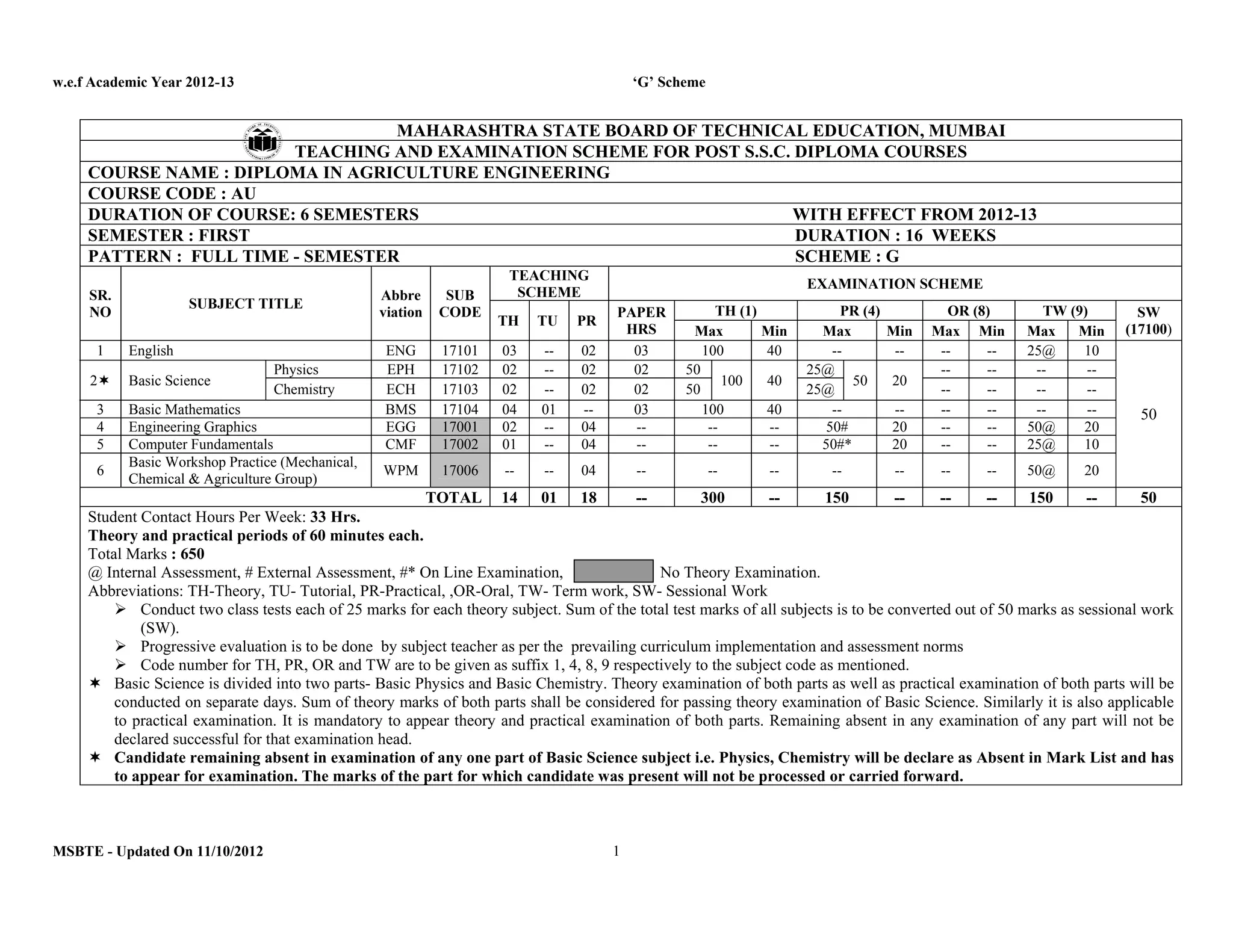
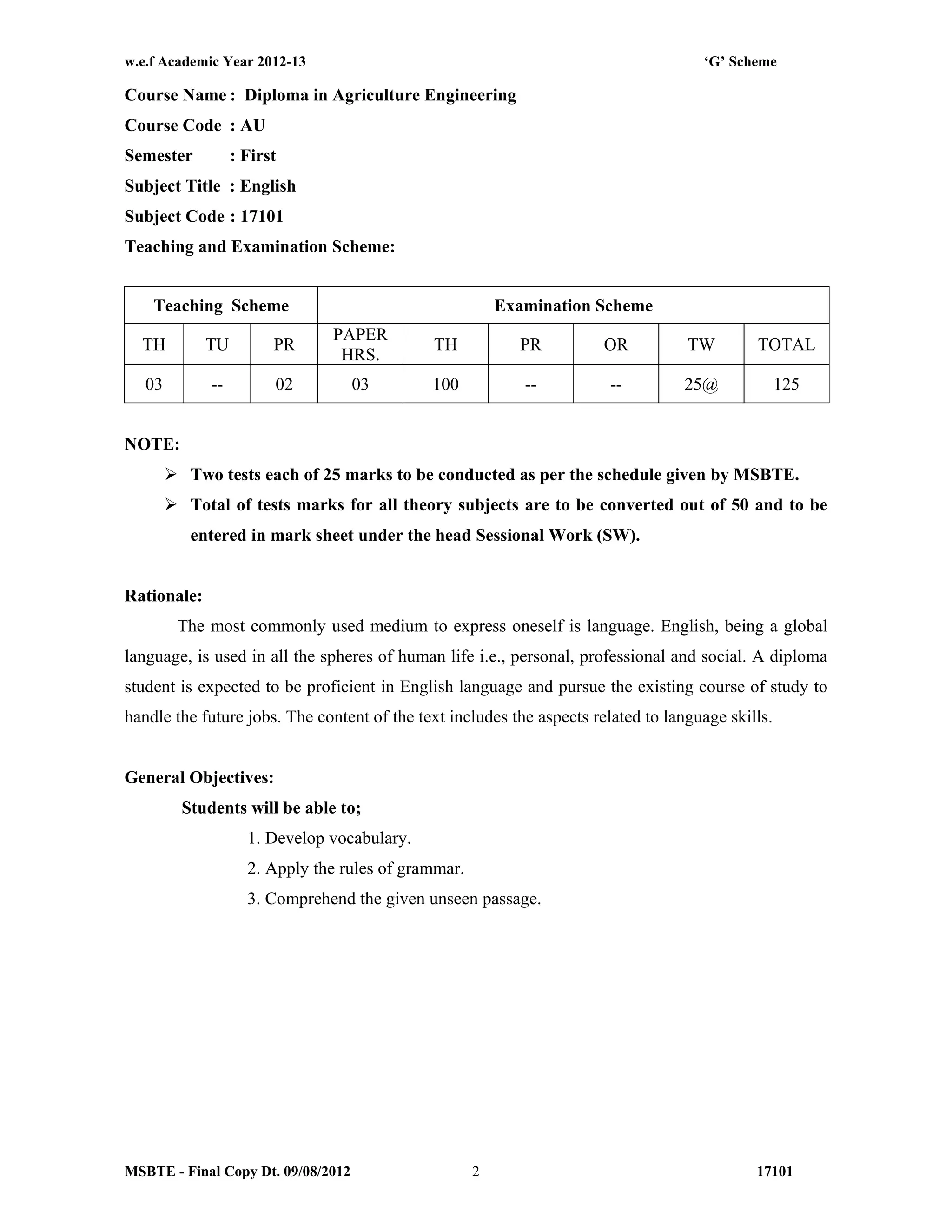
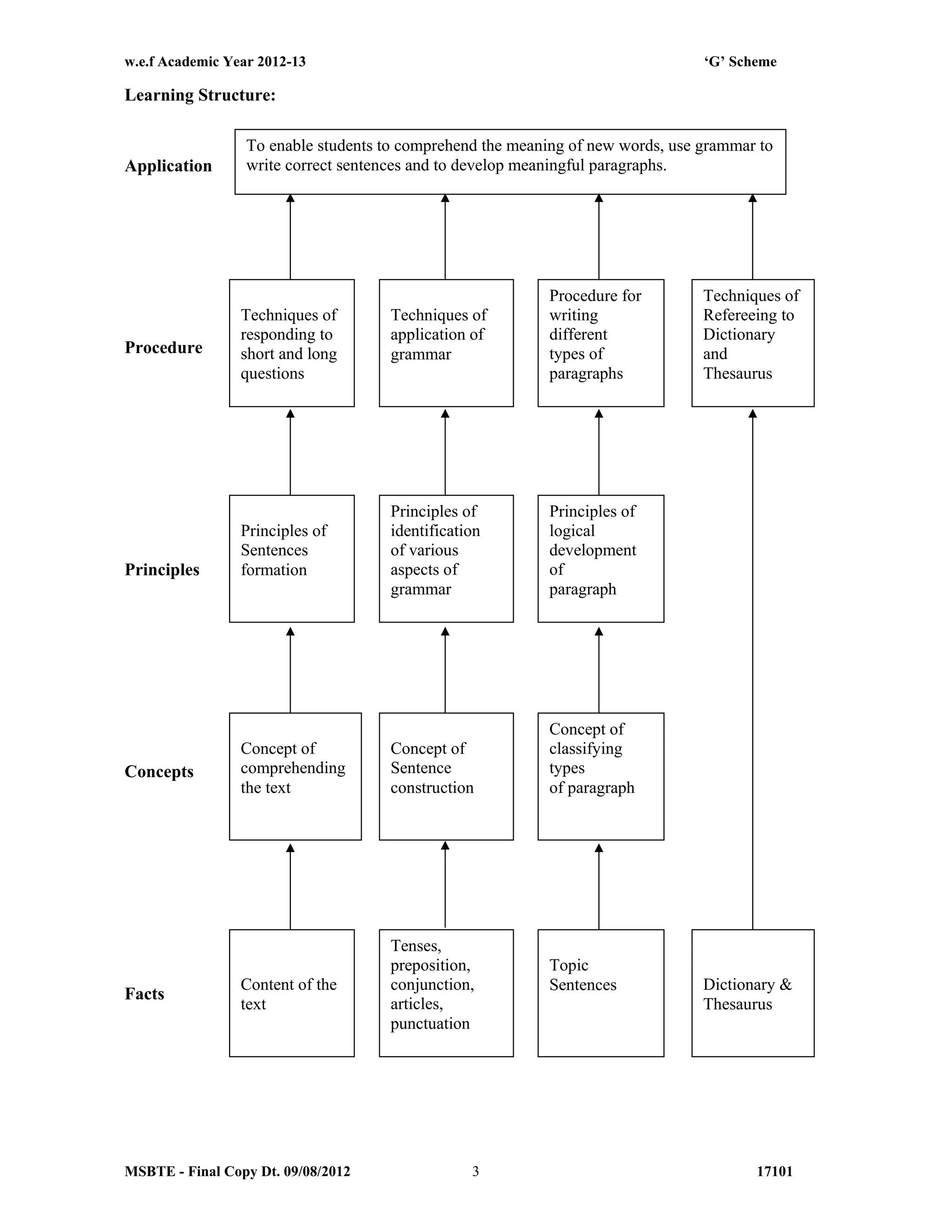
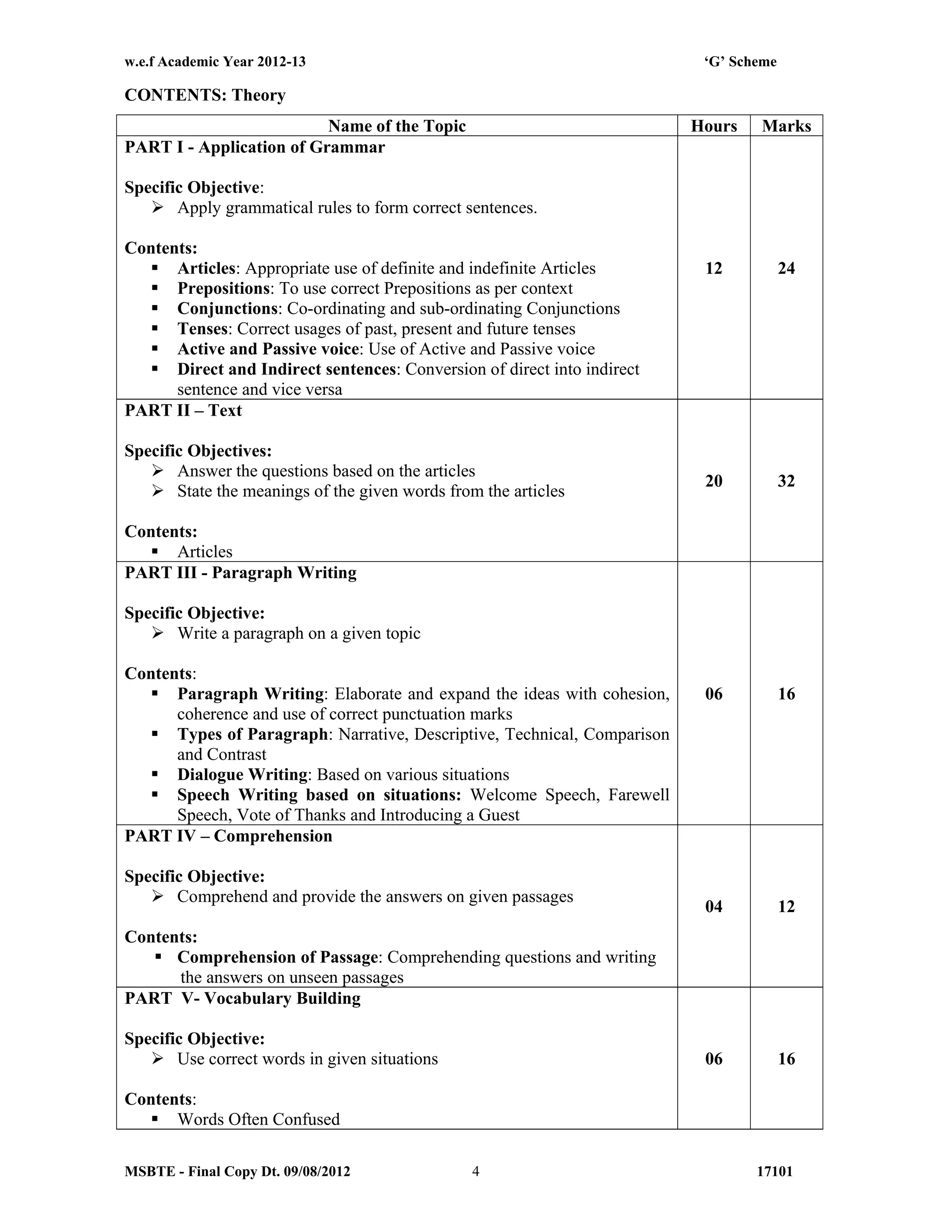
![w.e.f Academic Year 2012-13 ‘G’ Scheme
MSBTE - Final Copy Dt. 09/08/2012 171015
Collocation
Prefix and Suffix
Synonyms and Antonyms
Total 48 100
Skills to be developed in practicals:
Intellectual Skills:
1. Select appropriate words/verbs and formulate correct sentences
2. Develop ability of correct pronunciation
3. Report writing skills
Assignments:
Journal consists of the following assignments:-
1. Punctuate 25 sentences given by the teacher.
2. Rewrite the passage/passages with correct form of verbs. [Teacher is expected to give
passage /passages of verbs used wrongly [at least 25 verbs.]
3. Write 15 synonyms and 15 antonyms with the help of the thesaurus.
4. Write a paragraph each on descriptive, narrative, comparison, contrast and technical type
in 75 to 100 words.
5. Write 10 words of prefixes and 10 words of suffixes and use them in sentences.
6. Select one news from any English newspaper. The news may be from any one of the
following areas – Social, environmental, financial, economics, sports, etc. Prepare a
summary of the news and make it presentable by using relevant photographs/graphics.
7. Students will be given ten collocations, develop three sentences for each collocation.
NOTE: The following assignment should be performed in the Language Laboratory/with the
help of interactive media.
8. Listen and practice the dialogues with the help of interactive media/ interactive software.
Learning Resources:
Sr.
No.
Title Author Publisher
1 MSBTE TEXTBOOK ------------- MSBTE
2 ESSENTIAL ENGLISH GRAMMAR
RAYMOND
MURPHY
CAMBRIDGE
3
HIGH SCHOOL ENGLISH
GRAMMAR AND COMPOSITION
WREN AND MARTIN S CHAND & CO.](https://image.slidesharecdn.com/firstsemestercurriculumau-161209084708/75/First-semester-curriculum-au-5-2048.jpg)

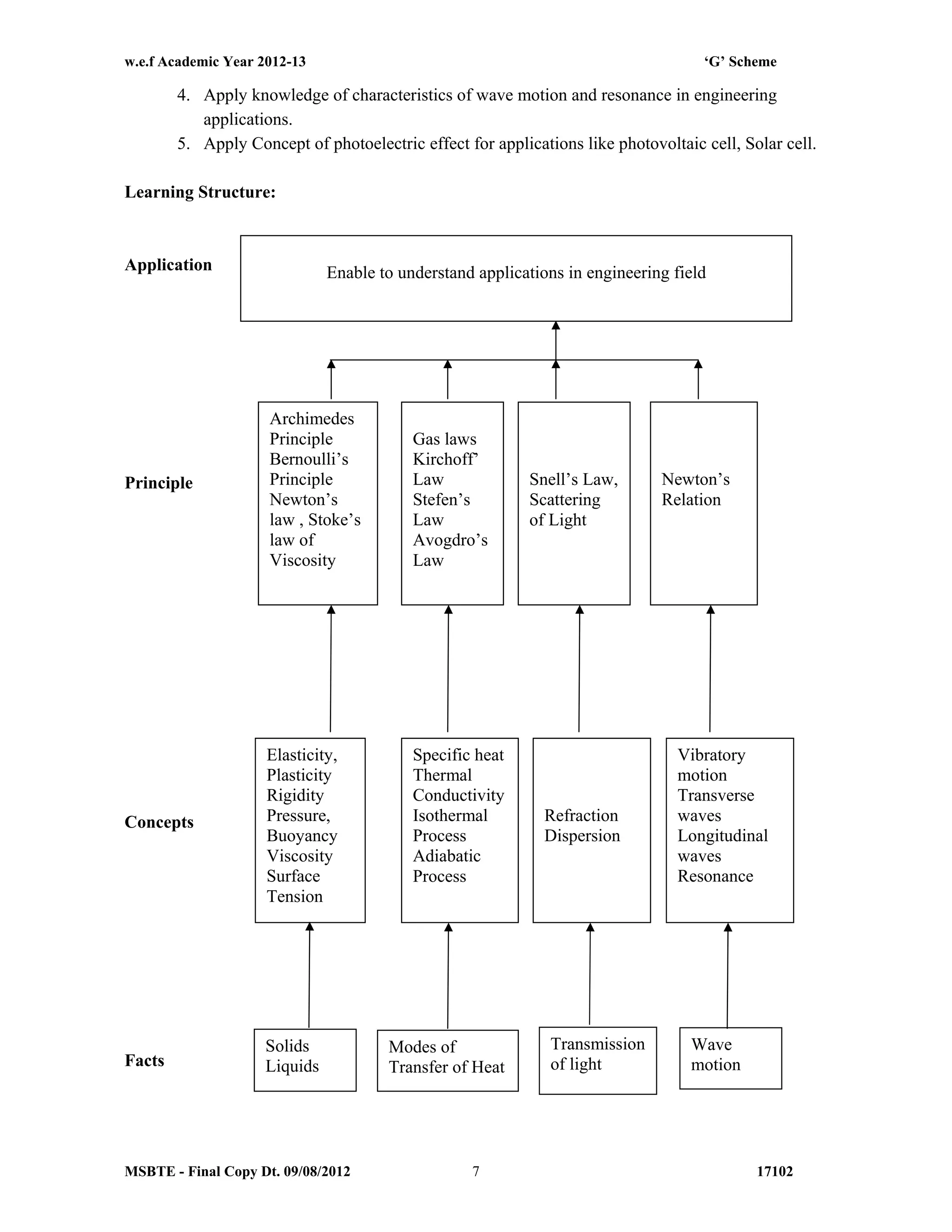
![w.e.f Academic Year 2012-13 ‘G’ Scheme
MSBTE - Final Copy Dt. 09/08/2012 171028
Theory:
Topic and Contents Hours Marks
Topic 1] Properties of solids:
Specific Objectives
Calculate the Young’s Modulus of material of wire.
Elasticity: Definitions of deforming force, restoring force, elasticity,
plasticity, Factors affecting elasticity.
Stresses: Tensile, Compressive, Volumetric and Shear stress,
Strains: Tensile, Volumetric and Shear strain.
Elastic limit, Hooke’s law.
Elastic co-efficient- Young’s modulus, bulk modulus, modulus of
rigidity and relation between them
Stress -strain diagram, behavior of wire under continuously increasing
load, yield point, ultimate stress, breaking stress, factor of safety.
compressibility, Poisson’s ratio.
05 08
Topic 2] Properties of liquids
Specific objectives:
Determine the surface tension of the given liquid
Determine the coefficient of viscosity by Stoke’s method.
2.1 Fluid friction: [ 8 Marks]
Pressure , pressure-depth relation (P = ρ h g), atmospheric pressure,
Pascal’s law, Archimedes’s principle.
Viscous force, definition of viscosity, velocity gradient, Newton’s law
of viscosity, coefficient of viscosity and its SI unit.
Streamline and turbulent flow with examples, critical velocity,
Reynold’s number and its significance.
Up thrust force, terminal velocity, Stokes law, and derivation of
coefficient of viscosity by Stoke’s method, effect of temperature and
adulteration on viscosity of liquid.
2.2 Surface tension : [4 Marks]
Cohesive and adhesive force, Laplace’s molecular theory of surface
tension, Surface Tension: definition and unit, effect of temperature on
surface tension.
Angle of contact, Capillarity and examples of capillary action,
derivation of expression for surface tension by capillary rise method,
applications of surface tension.
09 12
Topic 3] Thermal properties of matter:
Specific objectives:
Distinguish between isothermal and adiabatic process.
Determine the relation between specific heats.
3.1 Modes of transformation of heat : [6 Marks]
Difference between heat and temperature, definition of calorie,
Absolute zero, units of temperature: °C, °F,°K, with their conversion.
Conduction, law of thermal conductivity, coefficient of thermal
conductivity, good conductors of heat & insulators with suitable
examples, applications of conduction. Convection, applications of
convection. Radiation, applications of radiation.
3.2 Gas laws: : [6 Marks]
Gas Laws: Boyle’s law, Charles law, Gay lussac’s law (Statement and
08 12](https://image.slidesharecdn.com/firstsemestercurriculumau-161209084708/75/First-semester-curriculum-au-8-2048.jpg)
![w.e.f Academic Year 2012-13 ‘G’ Scheme
MSBTE - Final Copy Dt. 09/08/2012 171029
mathematical equation only)
Perfect gas equation (PV=RT) (No derivation), specific heat of a
substance , SI unit, specific heat of gas at constant volume (CV )
specific heat of gas at constant pressure (CP ), ratio of specific heat
,Mayer’s relation between CP and CV ,isothermal process, adiabatic
process, difference between isothermal process and adiabatic process.
Topic 4] Optics
Specific objectives:
Calculate refractive index of prism.
Determine the numerical aperture of optical fiber
Refraction of light : [ 6 Marks]
Refraction of monochromatic light, Snell’s law, Derivation of prism
formula, total internal reflection, critical angle.
Optical fibre: principle, structure of optical fiber, propagation of light
wave through optical fibre, derivation of numerical aperture and
acceptance angle.
04 06
Topic 5] Wave motion
Specific objectives:
Differentiate between transverse waves and longitudinal waves
Derive expression for displacement, velocity and acceleration of a body
executing SHM
5.1 Wave motion : [ 6 Marks]
Definition of a wave, wave motion, wave velocity, wave period, wave
frequency, wave length, vibratory motion, periodic motion, amplitude
of a vibrating particle, derivation of v = n λ
Simple harmonic motion (SHM), examples of SHM, equation of SHM,
expression of velocity and acceleration of a body executing SHM.
Types of progressive waves: transverse and longitudinal waves with
examples.
5.2 Resonance: [ 6 Marks]
Stationary wave, formation of stationary wave, examples of stationary
wave, characteristics of stationary waves, free and forced vibrations
with examples.
Resonance: definition of resonance, examples of resonance, formula to
calculate velocity of sound by resonance tube method.
06 12
TOTAL 32 50
Practical:
Skills to be developed
1) Intellectual skills-
Select proper measuring instruments
Verify the principles, laws, using given instruments under different conditions.
Read and interpret the graph.
Interpret the results from observations and calculations.
2) Motor skills-
Handle the instruments.
Measuring physical quantities accurately.
Observe the phenomenon and to list the observations in a tabular form.
Plot the graphs.](https://image.slidesharecdn.com/firstsemestercurriculumau-161209084708/75/First-semester-curriculum-au-9-2048.jpg)
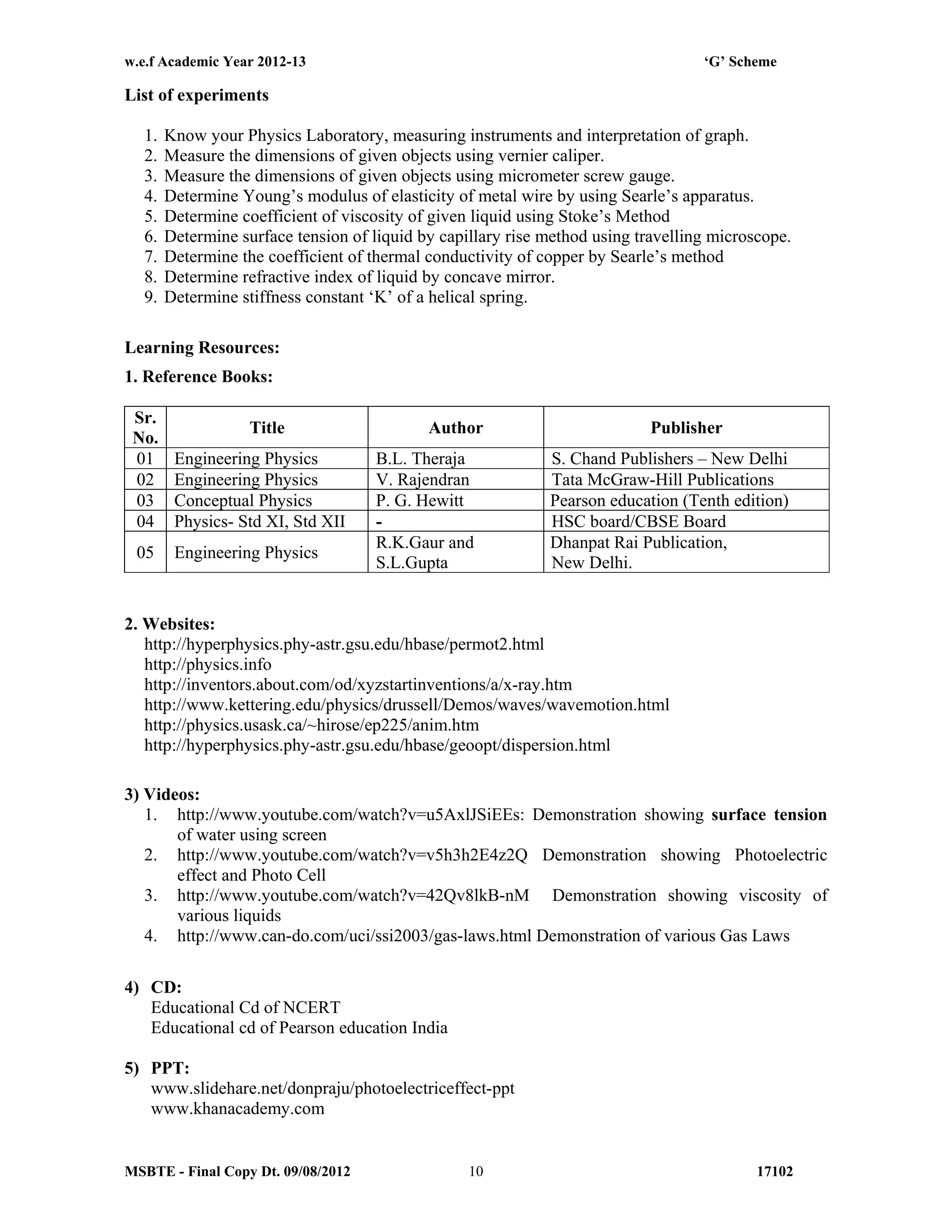
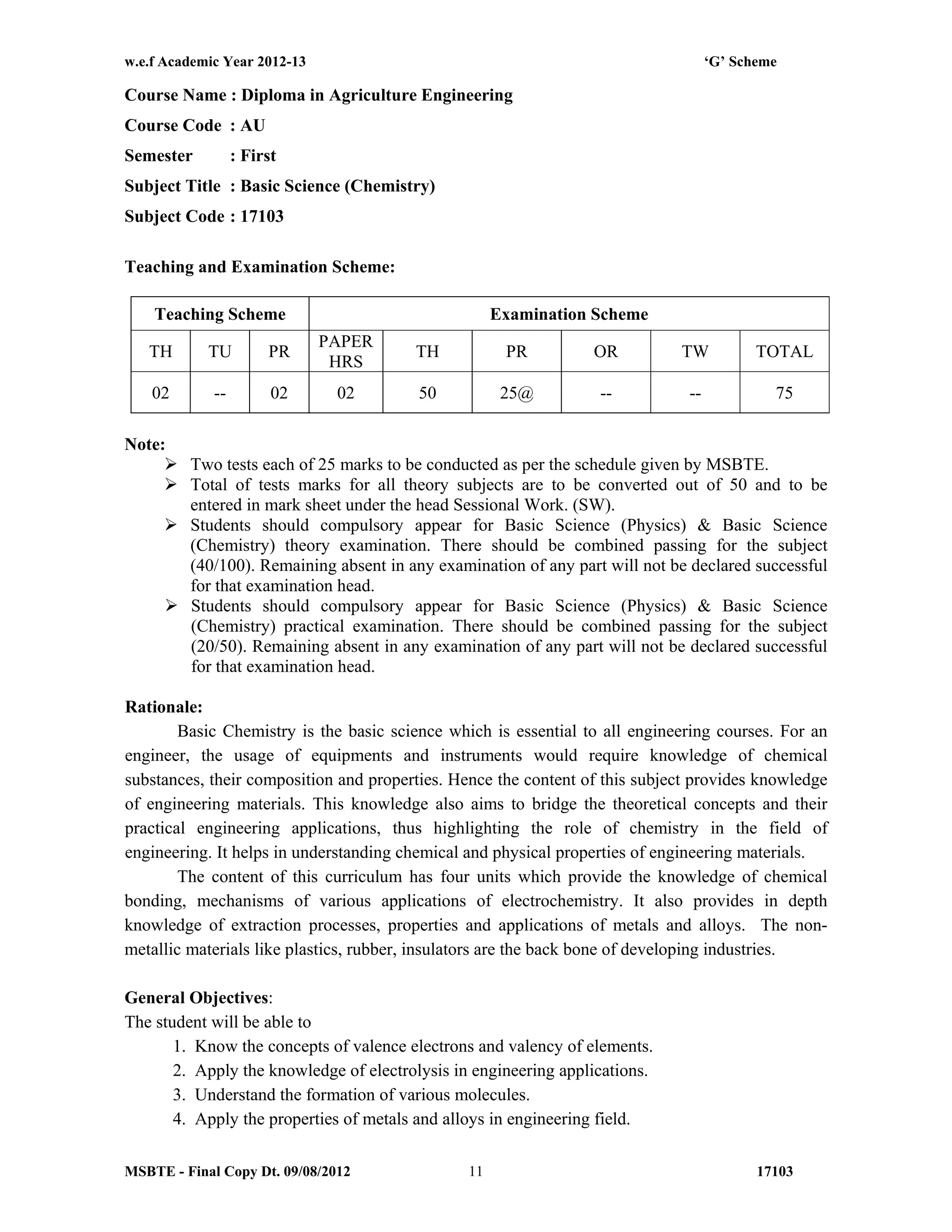

![w.e.f Academic Year 2012-13 ‘G’ Scheme
MSBTE - Final Copy Dt. 09/08/2012 1710313
Theory Content:
Topic and Contents Hours Marks
Topic 1] Chemical Bonding:
Specific Objectives:
Predict valence electrons and valency of elements.
Draw schematic diagram for formation of molecules.
1.1 Atomic Structure : [8 Marks]
Definition of atom, Bohr's atomic model, structure of modern atom,
characteristics of fundamental particles of an atom, definition of atomic
number, atomic mass number and their differences, Isotopes and Isobars:
Definitions, examples and distinction, applications of carbon and cobalt isotopes.
Orbits: Bohr’s energy levels, sub-energy levels, s, p, d, f orbitals, shapes and
description of s-orbital and p- orbital. Distribution of electrons in orbitals:
Definition of electronic configuration, Aufbau’s principle, Hund’s rule, orbital
electronic
configurations (s, p, d, f) of elements having atomic number 1 to 30,
1.2 Valency: [4 Marks]
Definitions of valence electrons, valency.
Definition of electrovalency, positive and negative electrovalency, formation
of Electrovalent compounds-MgO,CaCl2
Definition of covalency, single, double and triple covalent bonds, formation
of Covalent compounds H2O,CO2,N2
08 12
Topic 2] Electrochemistry:
Specific Objectives:
Describe the mechanism of electrolysis.
Identify the role of electrodes in application of electrolysis.
2.1 Basic concepts of electrolysis: [4 Marks]
Electrolyte, types of electrolyte- strong and weak electrolyte, their
difference.
Ionisation and electrolytic dissociation, Arrhenius theory of electrolytic
dissociation, degree of ionization, factors affecting degree of ionization.
Definitions of electrolytic cell, electrodes-cathode, anode, electrode
potential-oxidation potential and reduction potential.
2.2 Electrolysis: [10 Marks]
Mechanism of electrolysis- Electrolysis, electrochemical series for cations
and anions,
Mechanism of electrolysis of CuSO4 solution by using platinum
electrodes and copper electrodes
Applications of electrolysis- Electroplating of silver, electro refining of
blister copper,
Faraday's laws of electrolysis: Faraday’s first and second law, relation
between electrochemical equivalent and chemical equivalent, Numericals.
pH and pOH:
Definition of pH, pOH, pH Scale, Numericals.
10 14
Topic 3] Metals and Alloys:
Specific Objectives:
Identify the properties of metals and alloys related to engineering
applications.
Describe the process of extraction of metals.
3.1 Metals: [8 Marks]
08 12](https://image.slidesharecdn.com/firstsemestercurriculumau-161209084708/75/First-semester-curriculum-au-13-2048.jpg)
![w.e.f Academic Year 2012-13 ‘G’ Scheme
MSBTE - Final Copy Dt. 09/08/2012 1710314
Occurrence of metals in free and combined state, definitions- mineral, ore,
gangue, flux and slag, metallurgy.
Metallurgy- Detailed Flow chart for extraction of metal,
Important extraction processes-Concentration-gravity separation, electro-
magnetic separation, froth floatation, calcination and roasting, Reduction-
smelting, aluminothermic process, Refining- poling, electrorefining
Mechanical properties of metals- Hardness, ductility, malleability, tensile
strength, toughness, machinability, weldability, forging, soldering, brazing,
castability.
3.2 Alloys: [4 Marks]
Definition, purposes of making alloys with examples.
Preparation methods- Fusion, Compression
Classification of Alloys- Ferrous and non ferrous alloys with examples.
Examples of alloys- Composition, properties and applications of duralumin,
Woods metal, babbit metal.
Topic 4 ] Non-metallic Engineering Materials:
Specific Objectives:
Distinguish between thermosoftening and thermosetting plastics.
List the properties of rubber
State the applications of thermal insulators.
4.1 Polymers ( Plastics, Rubber) : [8 Marks]
Plastics: Definition of plastic, polymer, polymerisation, types of
polymerisation with examples.
Types of plastic- thermo softening plastics and thermosetting plastics and
their difference, properties and applications of plastics.
Rubber: Types of rubber.
Natural Rubber- definition, drawbacks of natural rubber, vulcanization of
rubber with chemical reaction, applications of vulcanized rubber.
Synthetic rubber- definition, difference between natural and synthetic
rubber, examples of synthetic rubber, properties of synthetic rubber like -
elasticity, tack, and abrasion resistance, their definition and related
applications.
4.2 Thermal Insulators [4 Marks]
Thermal Insulators -Definition, characteristics of thermal insulators,
classification- organic and inorganic thermal insulators, their examples,
preparation, properties and applications of thermocole and glasswool.
06 12
Total 32 50
Practical:
Intellectual Skills:
1. Analyse given solution and to find the chemical properties of metallic and non-metallic ions.
2. Interpret the results of experiments or numerical values.
3. Understand the set up of the experiment.
4. Verify the laws and characteristics.
Motor Skills:
1. Handle various laboratory reagents.
2. Accurately measure proper quantity of various chemicals.
3. Observe correct colour of precipitate, evolution of gas.
4. Connect electrical circuit as per the circuit diagram.](https://image.slidesharecdn.com/firstsemestercurriculumau-161209084708/75/First-semester-curriculum-au-14-2048.jpg)
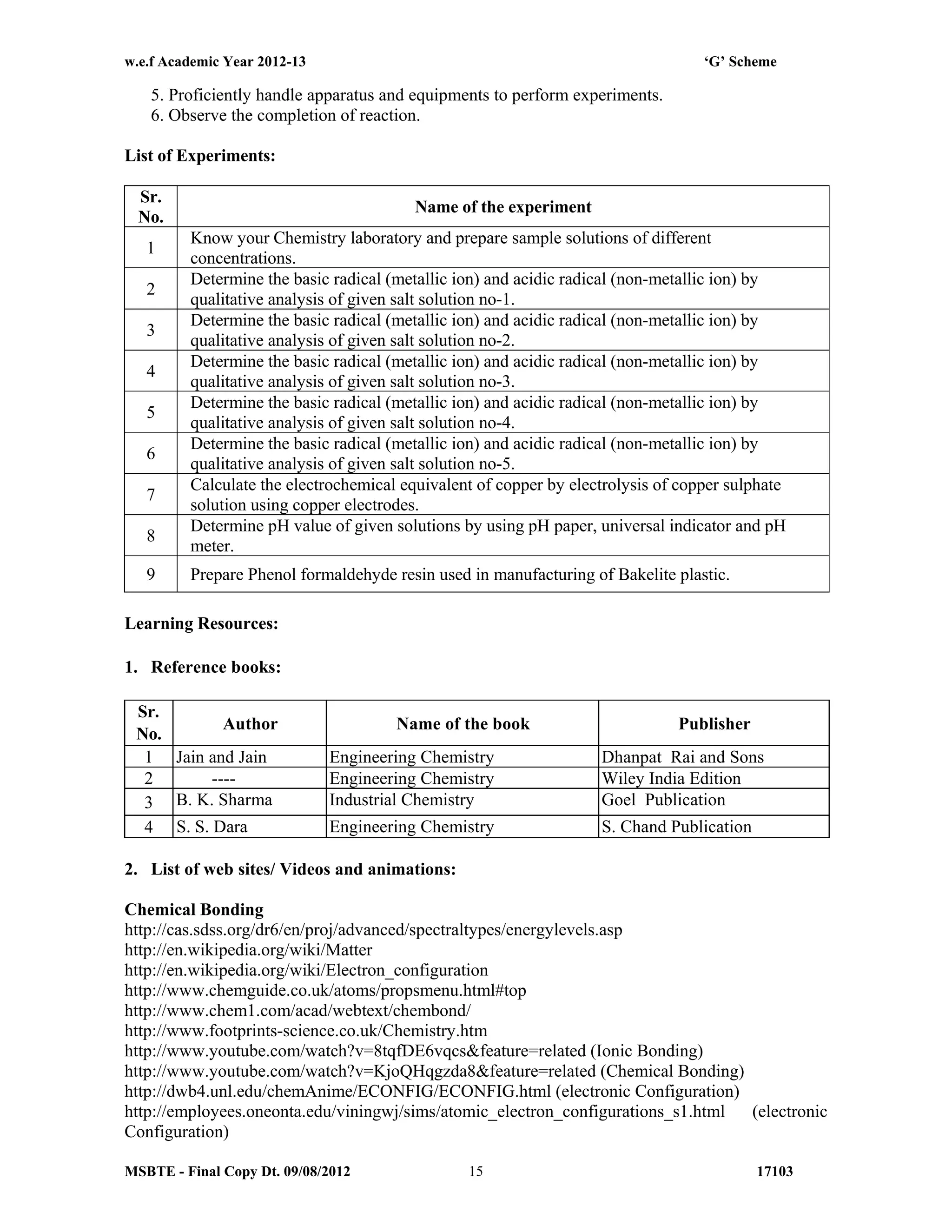

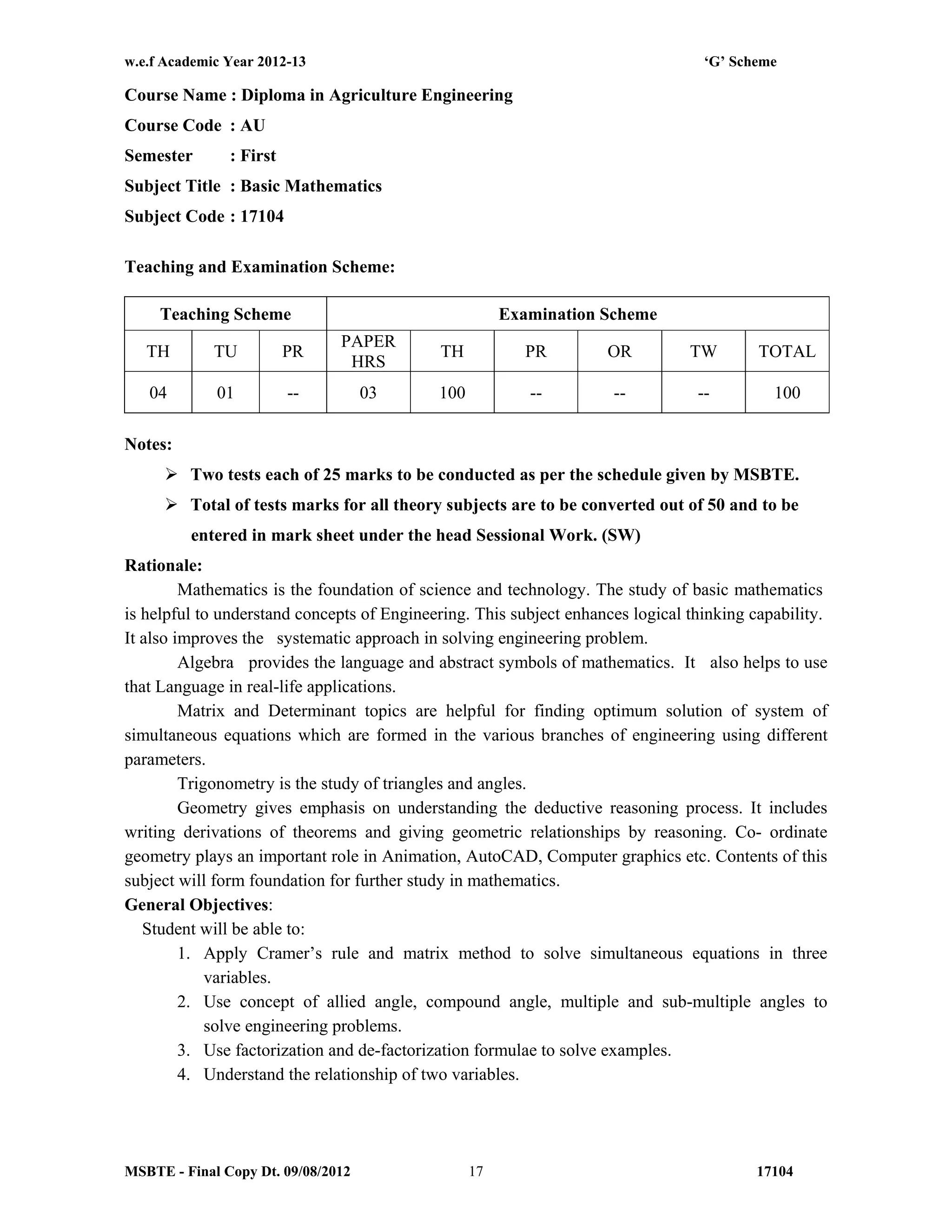



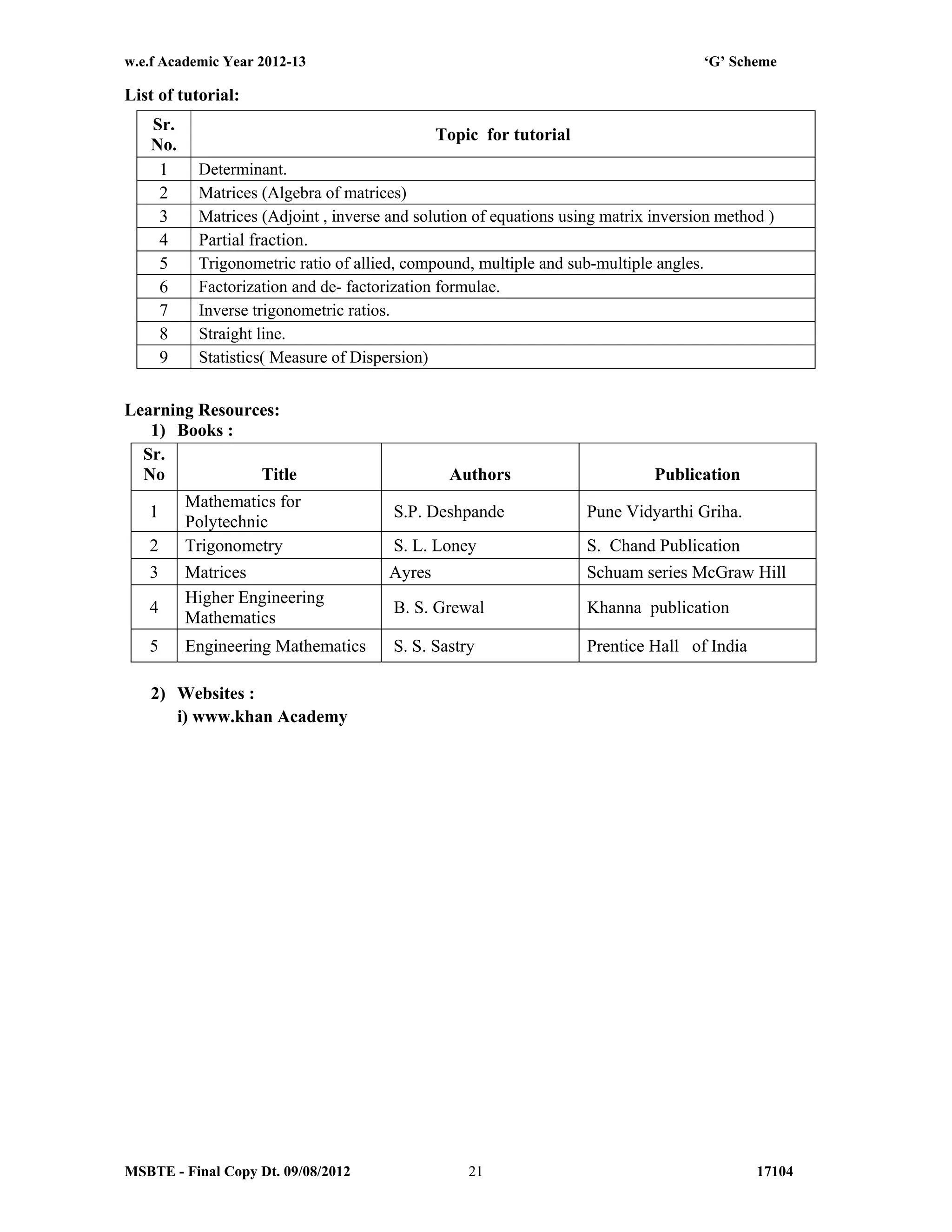




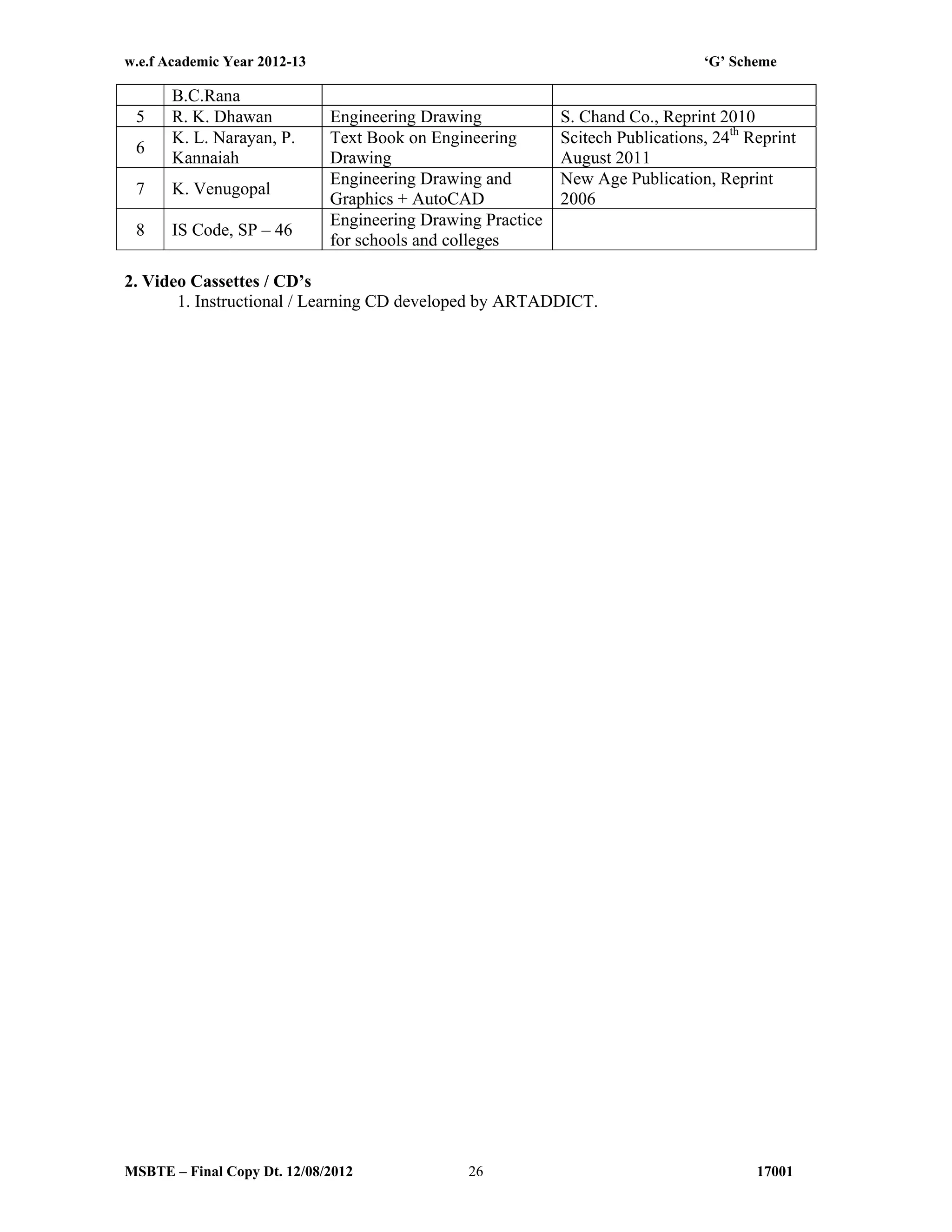

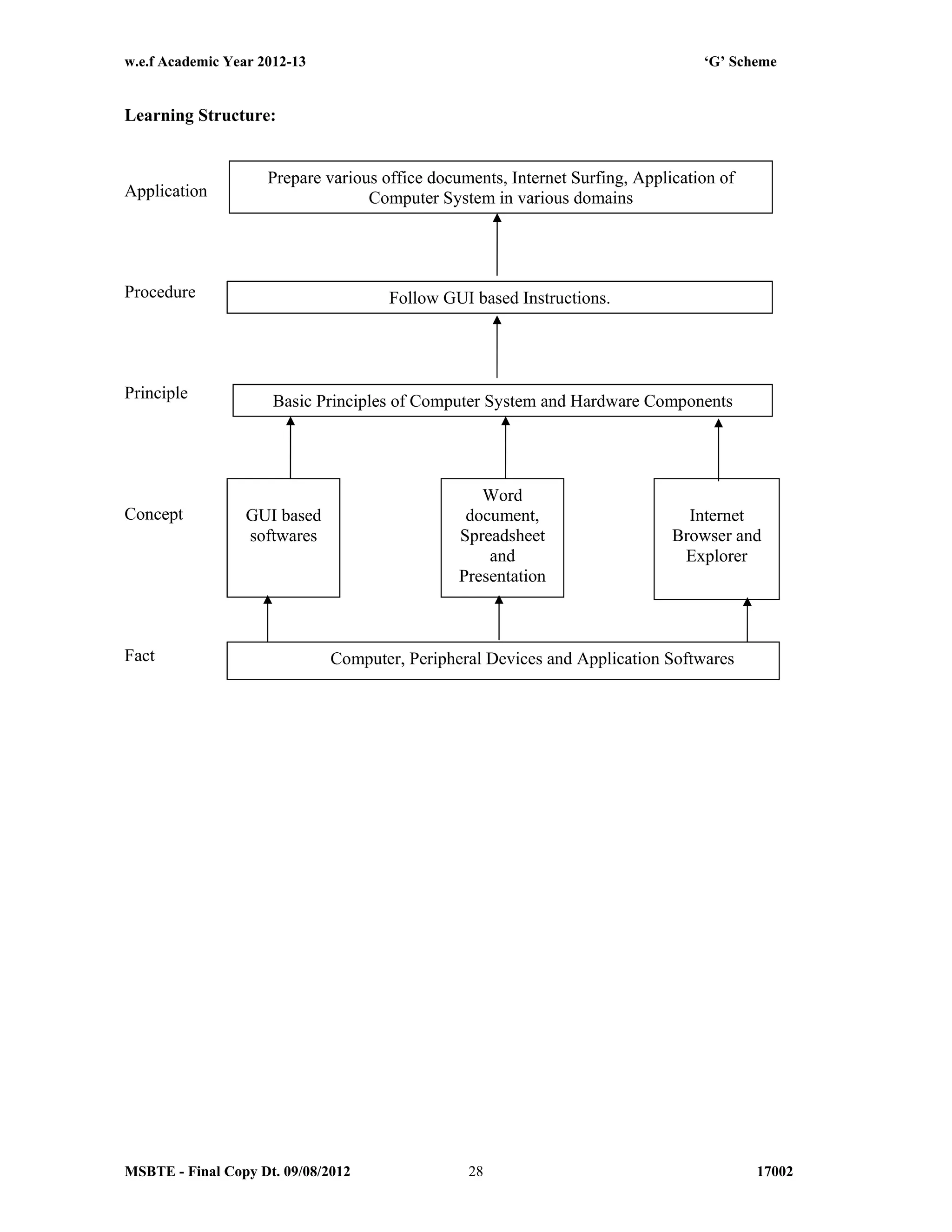

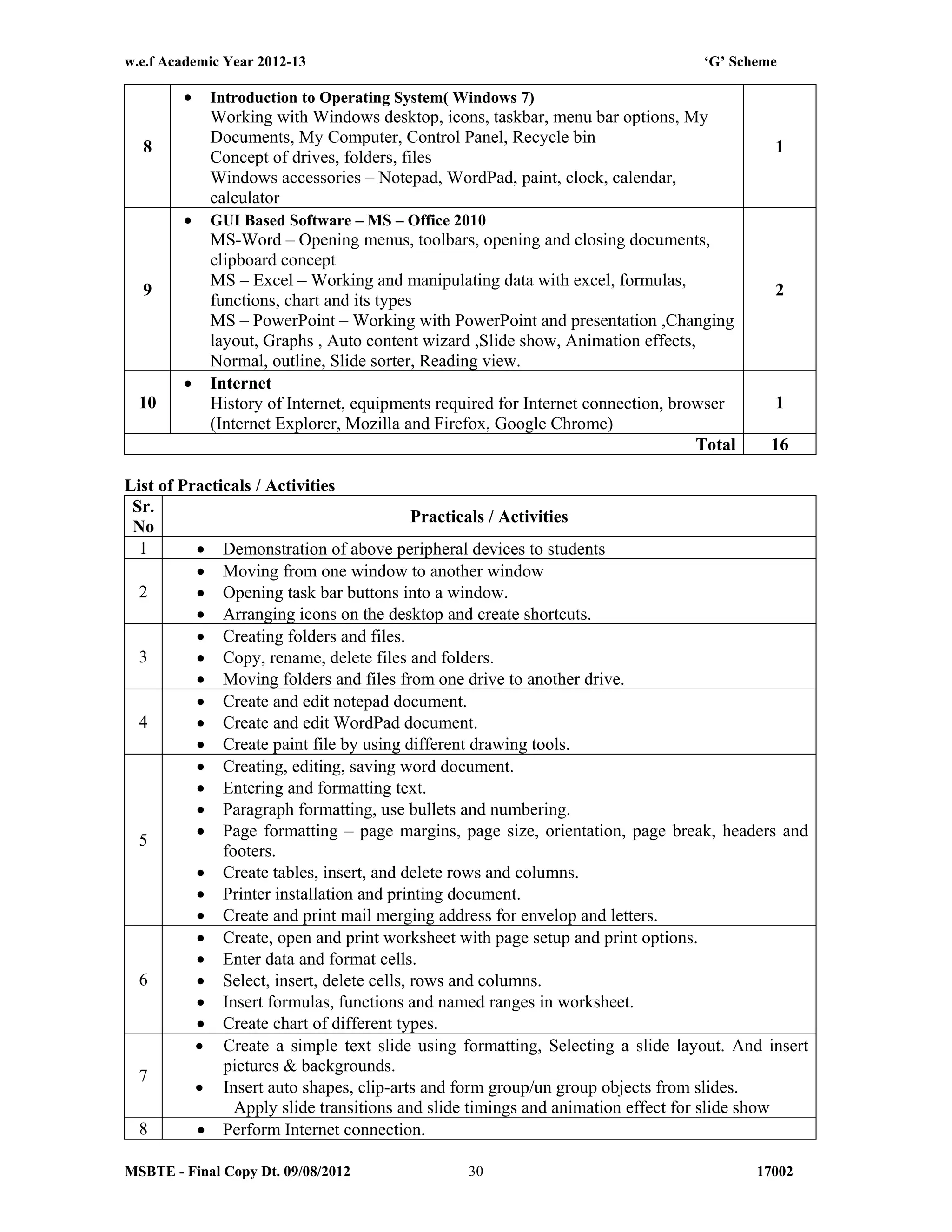
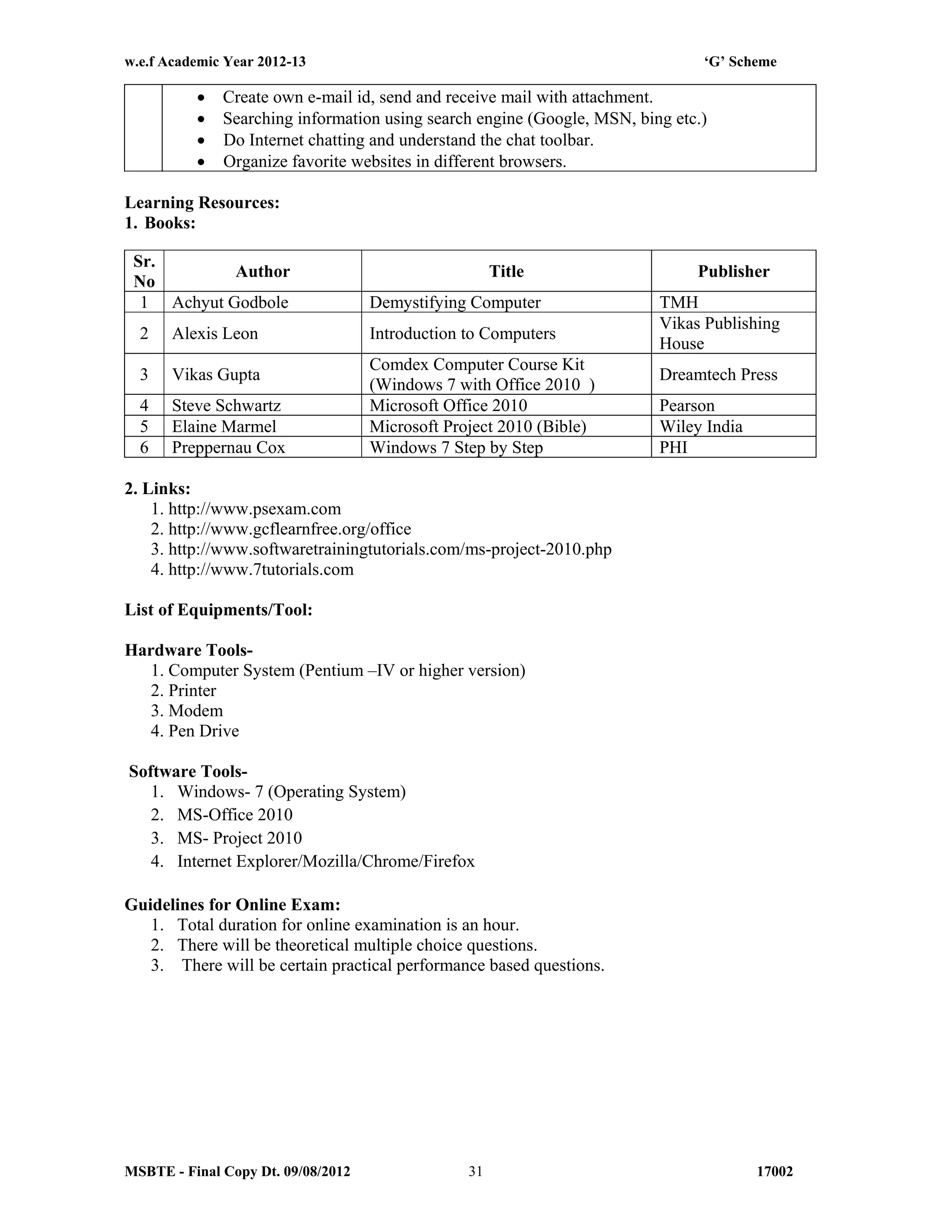


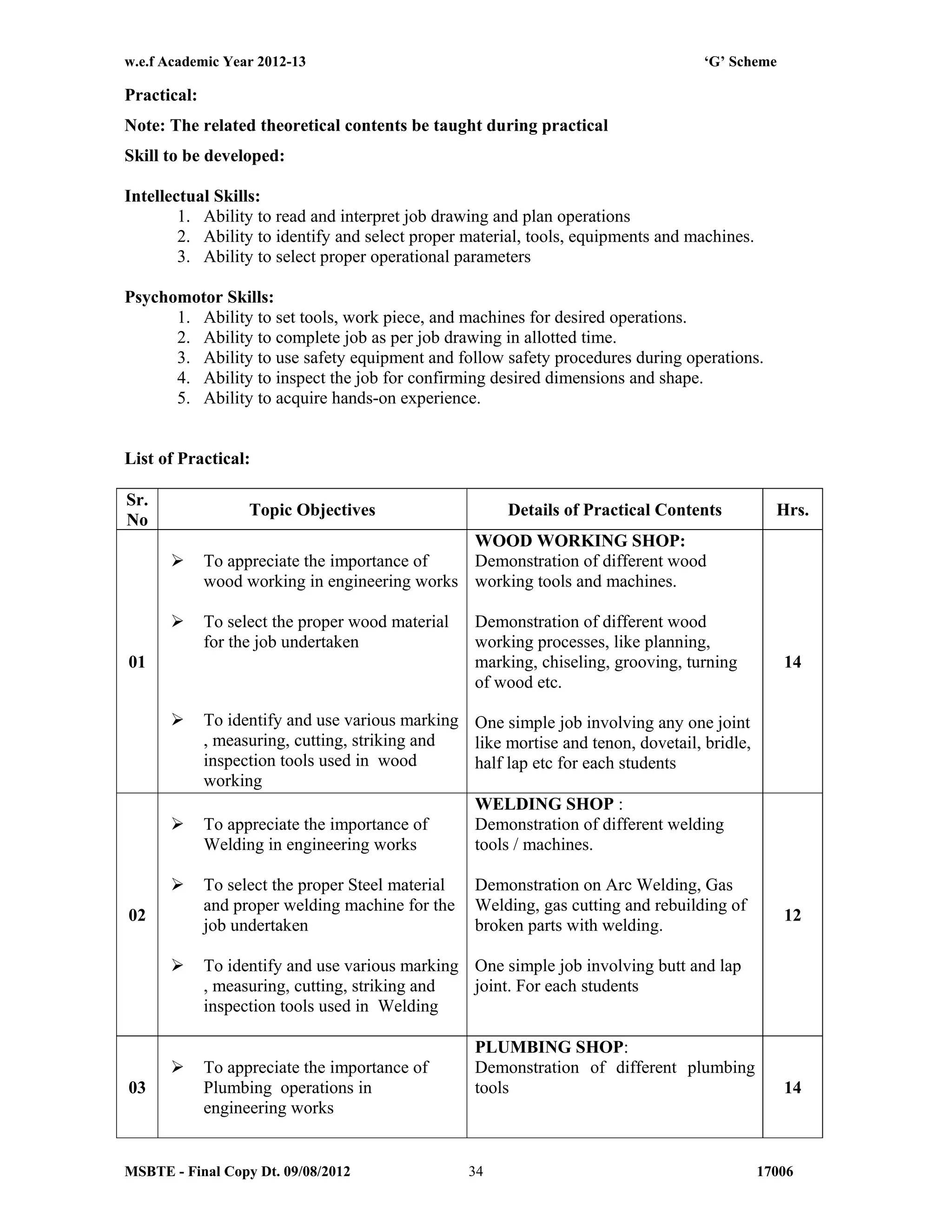

![w.e.f Academic Year 2012-13 ‘G’ Scheme
MSBTE - Final Copy Dt. 09/08/2012 1700636
Procedural steps in completing a given job
Description and drawings of different tools used
List of safety equipments used and safety rules observed during working
Notes:
1] The subject teacher should provide necessary theory inputs to students of all shops before
their actual practical.
2] The instructor shall give demonstration to the students by preparing a specimen job as per
the job drawing.
3] The workshop diary shall be maintained by each student duly signed by instructor of
respective shop
4] Workshop Tool Manual at institute level shall be provided to the students
5] Out of 50 marks allotted for term work, 40 marks are for actual jobs completed and 10
marks for assignment.
Learning Resources:
Books:
Sr.
No.
Author Title Publisher / Edition
01
S.K. Hajara
Chaudhary
Workshop Technology
Media Promotors and
Publishers, New Delhi
02
B.S.
Raghuwanshi
Workshop Technology
Dhanpat Rai and sons, New
Delhi
03 H.S.Bawa Workshop Practice
Tata McGraw Hill
Publishers,New Delhi
04 Kent’s Mechanical Engineering Hand book-
John Wiley and Sons, New
York
05
P. Kannaiah and
K. L. Narayana
Workshop Manual SCITECH Publications
06
Electronics Trade & technology Development Corporation.(A Govt. of India undertaking)
Akbar Hotel Annex, Chanakyapuri, New Delhi- 110 021
CDs, PPTs Etc.:
Learning Materials Transparencies and CDs, CBT Packages developed by N.I.T.T.E.R. and
other organizations
Refer website www.npkauto.com for Workshop Tool Manual
Workshop Manual by P. Kannaiah and K. L. Narayana , SCITECH Publications](https://image.slidesharecdn.com/firstsemestercurriculumau-161209084708/75/First-semester-curriculum-au-36-2048.jpg)